Your cart is currently empty!
What is Terracotta Made of? – A Look at Red Burning Clay
Published:
Last Updated:
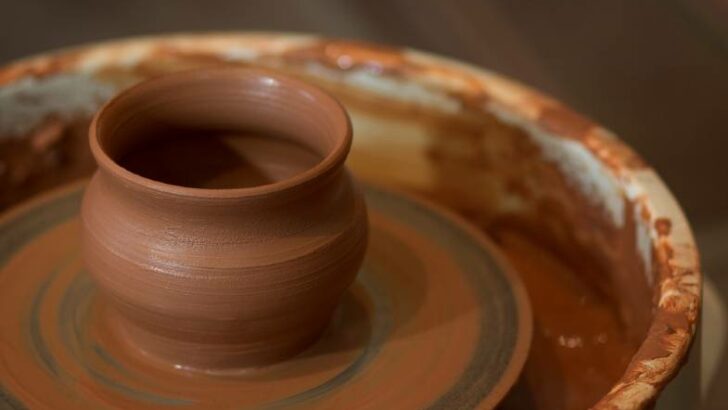
Affiliate Disclaimer
As an affiliate, we may earn a commission from qualifying purchases. We get commissions for purchases made through links on this website from Amazon and other third parties.
I’d always thought that terracotta clay should be fired at low temperatures. Firing basically means baking the clay in a kiln. But I bought some recently and the manufacturer’s spec said it could be fired up to 1181C (2158F). This is much higher than I thought, and it led me to question what I know about terracotta. In particular, I found myself wondering exactly what is terracotta made of? So, I looked into it, and this is what I discovered….
Terracotta refers to either ceramics made from terracotta clay or the clay itself. Terracotta clay has a high iron oxide content. It is this that gives it its distinctive red color. The iron is also partially why terracotta is a low fire clay. It’s also why it is porous when fired.
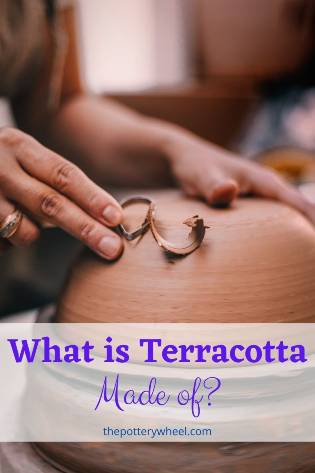
But First a Few Distinctions
Terracotta is sometimes written as terra cotta, and also terra-cotta. Almost all the sources I read pointed out that, in Italian, the literal meaning is ‘fired earth’. The Latin origin of the Italian term is Terra Cocta.
This seems simple enough, however, the term terracotta is used to refer to a few different things. These are:
- Type of clay body in its unfired state
- Ceramic items that are made from fired clay
- A particular red-brown color
To fully address the question of what terracotta is made of, it’s best to approach each of these uses in order. So, let’s start off with the clay itself, and dive into what this is made of….
What is Terracotta Clay Made of?
Terracotta clay is either dug up from the ground and then processed. Or it can be manufactured by combining different raw materials. Formulated clay like this is put together using a specific recipe that I’ll say a bit more about later.
Firstly, let’s take a look at clay that has been mined from the ground. Clay forms underground over many thousands of years. It is a combination of rock that has been worn to sediment by the elements, plus other minerals.
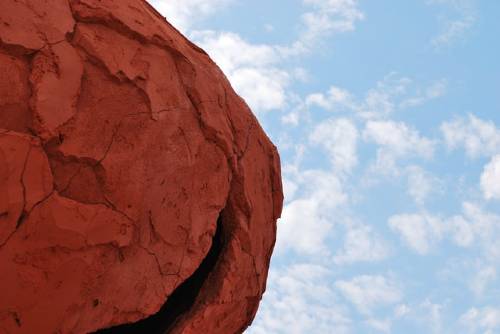
When rock is ground away from its source by the wind and rain it sometimes collects at its point of origin. Sediment that collects at its point of origin and turns to clay is called primary clay.
However, most rock sediment is moved by water and wind and collects at a different location. On its journey, it picks up impurities and contaminants. This is known as secondary clay. It contrasts with primary clay which is quite pure and uncontaminated.
Terracotta is a Secondary Clay
Terracotta is a good example of a secondary clay because it contains many contaminants and impurities. One of it’s key components is iron oxide. When terracotta is fired, its iron content interacts with the oxygen in the kiln and creates the distinctive red color.
Not all terracotta is red, some are grey or buff-colored when it is unfired. Most terracotta is red-burning, which means that it is red or orange-brown when it’s been fired. However, some fired terracotta has brown or pink hues.
The iron content doesn’t just have an impact on the color of the clay. It also affects the temperature the clay can tolerate in the kiln.
Iron functions as a flux. A flux is an oxide that lowers the temperature at which a mixture of materials will melt. Clay contains glass-forming ingredients like silica. When the clay is fired, these glass formers melt and fill up the spaces between the clay particles.
It is this process that enables clay to become non-porous once fired. The molten glass cools as the kiln cools, and the pores in the clay remain closed. This process is called vitrification.
So, a certain amount of melting is valuable when clay is being fired. But all clay has a temperature at which the actual clay body will melt once it has become too hot. This temperature varies between different types of clay.
Because terracotta contains iron and other fluxing ingredients, it will melt at a lower temperature than stoneware or porcelain.
Let’s take a look at what happens to it when it is fired at temperatures that are too high…
Terracotta is a Low Fire Clay
I have found quite a bit of conflicting information about the maximum temperature to which terracotta should be fired. These differences of opinion cropped up between different books that I read, and in online resources.
For example, the Potter’s Dictionary, by Hamer and Hamer, states that terracotta is ‘earthenware ceramics both glazed and unglazed’ (p370). And that earthenware is associated with being fired at ‘softer temperatures below 1100c (2012F)’, (p123).
By contrast, I referred to Ceramics for Gardens and Landscapes by Hessenberg. This book is about outdoor pottery and ceramics. And terracotta clay features quite heavily in the materials used by the potters discussed in the book.
Hessenberg cites different potters who fire their terracotta pieces at various temperatures. These temperatures range from 1040C (1904F), to 1170C (2138F).
Also, as I stated in my introduction, there are suppliers who advertise terracotta clay that fires up to cone 6. Cone 6 is a mid-fire temperature normally associated with stoneware clay.
In spite of these differences, I did find some agreement about firing temperatures. For example, Tony Hansen of Digital Fire states that ideally terracotta is fired between cone 04 and 03. This range is from 1070c (1958F) to 1101c (2014F).
In a discussion on the ceramic arts forum, various potters agreed that terracotta is a low fire clay. In this context low firing means between cone 06 and 04, which is 1011c (852F) to 1070c (1958F).
Vitrification
The process of vitrification described above happens on a spectrum. Some clay becomes more vitrified (non-porous) than others.
One reason for this is that some clays contain more glass-forming materials than others. Terracotta contains fewer glass-forming materials than other clays. However, it does contain some and will vitrify a bit when fired.
Vitrification makes the clay less porous and stronger. When terracotta is fired it can become partially vitrified. However, once it is partially vitrified, if the temperature in the kiln keeps increasing, the clay body will start to suffer.
Overfired terracotta will start to become very dense. This density makes it brittle rather than strong. It also warps, bloats up, and will eventually shatter or melt.
Hansen states that adding frit to terracotta can enable it to reach a higher degree of vitrification at lower temperatures. Frit is a kind of ceramic glass that is ground into a fine powder (source).
Whilst terracotta with added frit is less porous, it is still being fired at a lower temperature.
Other Additional Ingredients
Potters and sculptors will also sometimes add different types of sand and grog to terracotta. Grog is clay that has been fired once and ground up into granules.
Grog can add a gritty texture or tooth to clay and can help make it more resistant to frost. This is valuable if the piece being made is an outdoor sculpture or planter.
Sometimes ball clay is added to give the terracotta more strength once fired. Because fired terracotta is still quite porous it is also less strong than stoneware and porcelain. Typically, it is 10-12% porous when fired to cone 04 (1070C / 1958F).
Adding ball clay, which has very fine particles, makes clay more plastic and easier to shape. However, the fine particles also sit between the larger clay particles and add strength to the ware.
Terracotta Clay Recipes
As stated above, terracotta can be dug up from the ground and processed. Or it can be formulated using particular raw materials. The latter method is good for potters who need their clay to have very particular properties.
Linda Arbuckle published a very helpful paper on earthenware clay with a range of recipes for terracotta clay.
Sample Recipes
| Terry Siebert’s Terracotta | |
|---|---|
| Redart | 60 |
| Talc | 15 |
| AP Green | 15 |
| Ball Clay | 23 |
| St. John’s Terracotta 04 | |
|---|---|
| Redart | 50 |
| Goldart | 10 |
| AP Green | 10 |
| Ball Clay | 10 |
| Talc | 20 |
| Barium Carbonate | 0.5 |
One of the problems that can occur with fired terracotta is that white deposits can form on the pot. These are soluble salts that form a white scum on the surface of the ware. One way to prevent this is to add barium carbonate to the recipe. Hence the addition of barium carbonate to one of the recipes above.
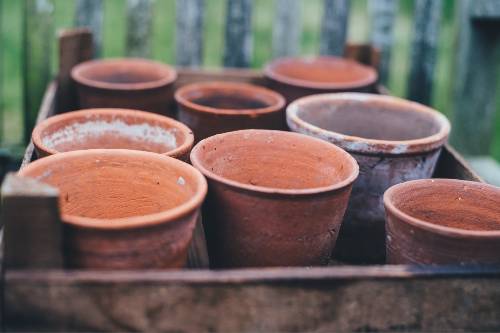
Both of the recipes above are for clay that is designed to be fired at around cone 1070C / 1958F.
As you can see, many potters are of the opinion that terracotta is low fire clay. But if that’s the case, why is some clay described by suppliers as being suitable for mid-fire temperatures.
One possibility is that these clays are really closer to being stoneware than earthenware clays. Some stoneware clay has a red terracotta look. In fact, there is a particular clay that is called terracotta stoneware. But on inspection, it’s clay that is described as being ‘terra cotta colored bisque’.
Essentially, terracotta clay is a high iron content earthenware that fires at a lower temperature than stoneware and porcelain. Because of the high iron content, it is most often red-burning, but can also be formulated to fire at other colors. These include brown, pink, yellow, orange, and sometimes cream.
Terracotta Ceramics
The term terracotta is also used to describe a variety of different ceramic products. I don’t normally quote Wikipedia, but I thought this was quite funny. “Terracotta: a term used for a rather random group of types of objects, rather than being defined by technique”. This seems just about right to me.
Over the centuries, terracotta has been used to make many kinds of items. This range includes figurines, sculptures, architectural structures, tiles, planters and plant pots, and dinner ranges. It has a long history of being used which dates back to the Neolithic era.
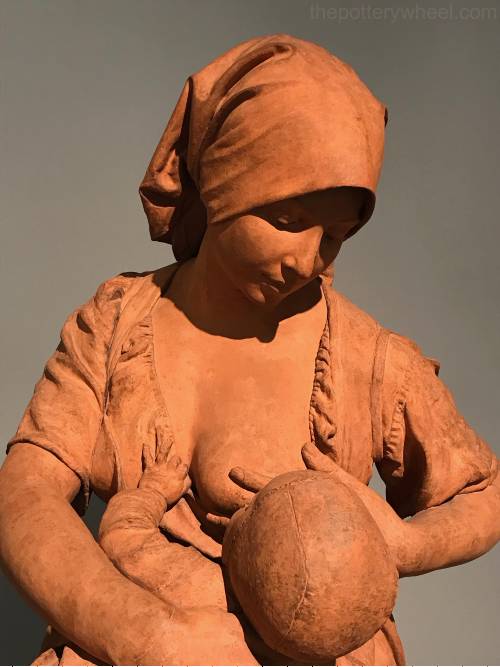
As stated above, fired terracotta clay is more porous than stoneware or porcelain. When ceramics are fired to ‘maturity’ it means that they have become as dense and strong as they can be. Mature stoneware and porcelain are impervious to water. By contrast, well-fired terracotta is still absorbent.
Making ceramics water-tight can be done in a few ways. One option is to coat the ceramics with glaze. Put simply, pottery glaze is finely ground glass particles suspended in water. It does also include other ingredients, let’s keep it simple for now.
Glaze is usually applied to clay that has been fired once and turned into ceramic. The first firing is the bisque fire. The glazed bisque ware is then fired again. During the second firing, the glass in the glaze melts onto the surface of the pottery.
When the glaze layer cools it forms a water-tight barrier, that prevents water absorption. Glazing is most often used to make terracotta dinnerware fit for purpose.
Sometimes the term terracotta is reserved for unglazed pottery made from terracotta clay. By contrast, glazed terracotta is often referred to as being ‘earthenware’.
Alternative Ways to Seal Terracotta
Of course, not all potters or sculptors want to glaze their terracotta ware. Most planters used to decorate outside space are left unglazed. But does that mean the terracotta is unprotected? Not really. Ceramic artists who make work to be installed outside need to think carefully about how to protect their pottery from the elements.
Frost and freezing temperatures are the biggest threat to outdoor ceramics. This is a concern for potters who use porous clay. When water freezes it expands. If water is absorbed into ceramics and then freezes, it can crack the ware as it expands.
One way to address this issue is to reduce porosity. This can be done by either adding frit to the clay. As described above, this increases the amount of vitrification that occurs at lower earthenware temperatures.
Alternatively, other ingredients can be added to the clay so that it can tolerate being fired at higher temperatures. Another solution is to apply a sealant to the fired terracotta.
Silicone-based sealants used in the building trade can help. Sealants of this kind are injected into brickwork by builders to make the brick impermeable to water.
Applying a coat to a porous sculpture can have the same effect. Rainwater will ball up and run off the sculpture, rather than being absorbed into the piece.
Final Thoughts
In short, terracotta is made of clay that has a high iron content and is fired at earthenware temperatures. The iron content accounts for the fact that it is red burning, meaning it turns red when it’s fired. It also contributes to the fact that it is a low-fire clay. But within this broad account of what goes into making terracotta, there is also lots of variety. There are different recipes, brands, and ways of glazing and firing terracotta.



